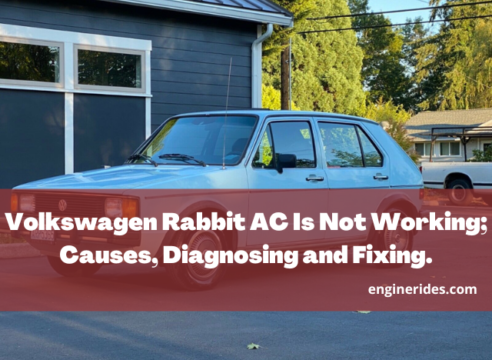Can WD-40 Be Used as Starter Fluid? By EngineRides
When it comes to starting engines, having the right tools and products is crucial. Two commonly known items are WD-40 and starter fluid. However, there is often confusion about whether WD-40 can be used as a substitute for starter fluid.
In this article, we will explore the characteristics of WD-40 and starter fluid, explore their differences, and discuss the viability of using WD-40 as starter fluid. Welcome to EngineRides.
Table of Contents
What really is WD-40?

WD-40 is a widely recognized and versatile product renowned for its lubricating and penetrating properties. Comprised of a unique blend of solvents, oils, and additives, WD-40 has a multitude of applications.
It is commonly used for tasks such as loosening rusted parts, displacing moisture, and protecting against corrosion. WD-40 is a staple in various industries and is also widely used for household maintenance and repairs.
What is Starter Fluid?
In contrast, starter fluid is specifically designed to aid in starting engines, particularly in cold weather conditions.
Its primary purpose is to provide a highly explosive mixture that facilitates the ignition of the fuel-air mixture in the engine’s cylinders, initiating the combustion necessary for the engine starting.
Starter fluid typically consists of volatile hydrocarbons, such as ether or ethylene, with low flashpoints and high flammability.
Can WD-40 Be Used as Starter Fluid?
Although WD-40 and starter fluid may share similar aerosol can packaging, they are fundamentally different products with distinct purposes. It is important to note that WD-40 should not be used as a substitute for starter fluid.
WD-40 lacks the specific volatile hydrocarbons found in starter fluid, which are crucial for rapid ignition. Attempting to use WD-40 as starter fluid can result in inefficiency and potential safety hazards.
Using WD-40 as a substitute for starter fluid presents several risks and limitations. WD-40 is not formulated to meet the high combustion requirements of engines. Its flashpoint is higher compared to starter fluid, meaning it may not ignite as readily. Prolonged use of WD-40 in the engine’s combustion chamber can lead to carbon buildup, potentially causing performance issues and damaging engine components.
Can You use butane as starter fluid?
Using butane as a starter fluid is not recommended. While butane is flammable and can potentially ignite, it is not formulated specifically for engine starting purposes. Engine starter fluids have specific additives for reliable ignition.
Butane may not provide the necessary combustion properties and can pose safety risks if not handled properly. It’s best to use a recommended starter fluid for engines.
What are the alternatives to Starter Fluid?
Instead of relying on WD-40 as starter fluid, using products specifically designed for engine starting is advisable. Several alternatives are available in the market, such as commercially available starter fluids or products specifically formulated for this purpose.
These alternatives contain volatile hydrocarbons and additives facilitating easy ignition and efficient engine starting.
Following safety precautions and best practices is crucial when using any starter fluid or similar products. Adequate ventilation should be ensured, and the product should be kept away from open flames or sparks.
It is essential to adhere to the manufacturer’s instructions strictly. Excessive use of starter fluid should be avoided, as prolonged exposure can harm engine components.
Can I spray WD-40 into the air intake?
Spraying WD-40 directly into the air intake of an engine is not recommended. WD-40 is not designed to be used as a fuel or combustion enhancer and can cause damage to the engine if used in this manner.
The air intake is responsible for delivering air to the engine for combustion, and introducing WD-40 into this system can disrupt the engine’s proper functioning.
WD-40 is primarily intended for lubrication, rust prevention, and moisture displacement. It is not formulated to withstand the high temperatures and pressures inside the combustion chamber. Using WD-40 in the air intake can lead to incomplete combustion, carbon buildup, and potential damage to engine components.
When should you not use WD-40 in vehicles?
While WD-40 can be useful in many automotive applications, there are a few instances where it is not recommended to use WD-40 on vehicles:
Brake Components: WD-40 should never be applied to brake components such as brake pads, rotors, or calipers. It can contaminate the braking system and reduce its effectiveness, leading to unsafe driving conditions. Instead, use brake cleaners or specific brake lubricants recommended by the manufacturer.
Drive Belts and Tires: WD-40 should not be used as a lubricant for drive belts or as a tire shine product. It can cause the belts to slip or deteriorate, leading to poor vehicle performance and potential damage. For drive belts, use belt dressing or other suitable lubricants. For tires, choose products specifically designed for tire care and maintenance.
Electrical Connections: While WD-40 can displace moisture and help prevent corrosion, it should not be used directly on electrical connections. It is always best to use electrical contact cleaners or dielectric grease for electrical maintenance to ensure proper conductivity and prevent damage to sensitive electrical components.
Engine Components: WD-40 should not be used as a substitute for proper engine lubricants or penetrating oils. It is not formulated to withstand the high temperatures and pressures inside the engine. For engine maintenance, use appropriate oils and lubricants recommended by the vehicle manufacturer.
Mufflers and Exhaust Systems: WD-40 should not be sprayed on mufflers or exhaust systems. These components can reach extremely high temperatures during operation, and WD-40 is flammable. Using WD-40 on these parts can create a fire hazard.
It’s important to refer to the vehicle’s owner’s manual and follow the manufacturer’s recommendations for maintenance and lubrication products specific to your vehicle.
Conclusion
In conclusion, while WD-40 is a versatile and valuable product for various applications, it should not be used as a substitute for starter fluid. WD-40 and starter fluid serve different purposes, and their compositions and characteristics differ significantly. When starting engines, using the appropriate tools and products specifically designed for the task is important. By choosing the right starter fluid and following proper safety guidelines, you can ensure a smooth and efficient engine start-up experience.








2 Comments